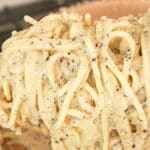Authentic Cacio e Pepe (VIDEO)
Cacio e Pepe is the perfect 20 minute dinner with only a few ingredients - just pasta, pecorino cheese, black peppercorns, and pasta water combine together to make a deliciously creamy sauce without using cream!
Servings: 2
Equipment
Ingredients
- 8 oz spaghetti dried pasta weight
- 2 oz pecorino cheese grated
- 1 cup reserved pasta water cooled to 150F (70C), used as needed to achieve an emulsified sauce in step 3
- 1/2 tbsp whole black peppercorn
Instructions
- Toast whole peppercorns over medium high heat for 2-3 minutes until the peppercorns are toasted and fragrant. Transfer to a pepper grinder or mortar and pestle and grind to a medium coarse grind. Add back to your pan with the heat off.
- Cook your spaghetti (or pasta of choice) in lightly salted water. 2 minutes before the pasta is done, reserve 1 cup of pasta water and set on the counter to let cool to about 150F or 70C - this is the key to avoiding lumpy cheese! Adding pasta water straight from the pot is much too hot.
- While the heat is off and the pan is cool to the touch, add the grated cheese to the peppercorns along with a 1/4 cup of the cooled pasta water at a time, stirring until you get a loose but emulsified sauce.
- Add your drained pasta and mix vigorously. At this point your pasta should start to absorb the sauce, but add additional pasta water and mix if the sauce is too thick. Continue mixing until you achieve the correct consistency (refer to video). Serve immediately into warmed bowls and enjoy!
Video
Notes
Cacio e Pepe is traditionally made with some kind of long pasta (noodle); I like to use spaghetti but I've also seen it with bucatini, linguine, fettuccine, and even tagliatelle. You can use either dry or fresh pasta. If you use dry pasta, my recommendation is to use bronze-cut pasta, as the surface of the pasta allows for more sauce to cling to it.
You will be using freshly grated pecorino romano cheese for this recipe - I like to use a microplane. I rarely recommend using pre-grated cheese in my recipes, as they are usually coated with preservatives to keep the shreds from melting and clumping together. I definitely do not recommend using pre grated cheese for this recipe.
You can substitute parmesan reggiano for the pecorino 1:1, however you may need to add more salt to taste, parmesan cheese is less salty.
My #1 tip for perfect Cacio e Pepe - your pasta water needs to be cooled slightly to 150 degrees Fahrenheit or 70 degrees Celsius BEFORE mixing it into the sauce. The reason is that your pasta water, which was just boiling to cook your pasta, is oftentimes TOO HOT - which leads to the sauce becoming clumpy. I noticed that once I started waiting for my pasta water to cool to 150 degrees Fahrenheit (or 70 degrees Celsius), I stopped having any issues with my sauce becoming clumpy.
Nutrition
Calories: 432kcal | Carbohydrates: 66g | Protein: 20g | Fat: 9g | Saturated Fat: 5g | Polyunsaturated Fat: 1g | Monounsaturated Fat: 2g | Cholesterol: 29mg | Sodium: 346mg | Potassium: 247mg | Fiber: 3g | Sugar: 2g | Vitamin A: 131IU | Calcium: 331mg | Iron: 2mg
